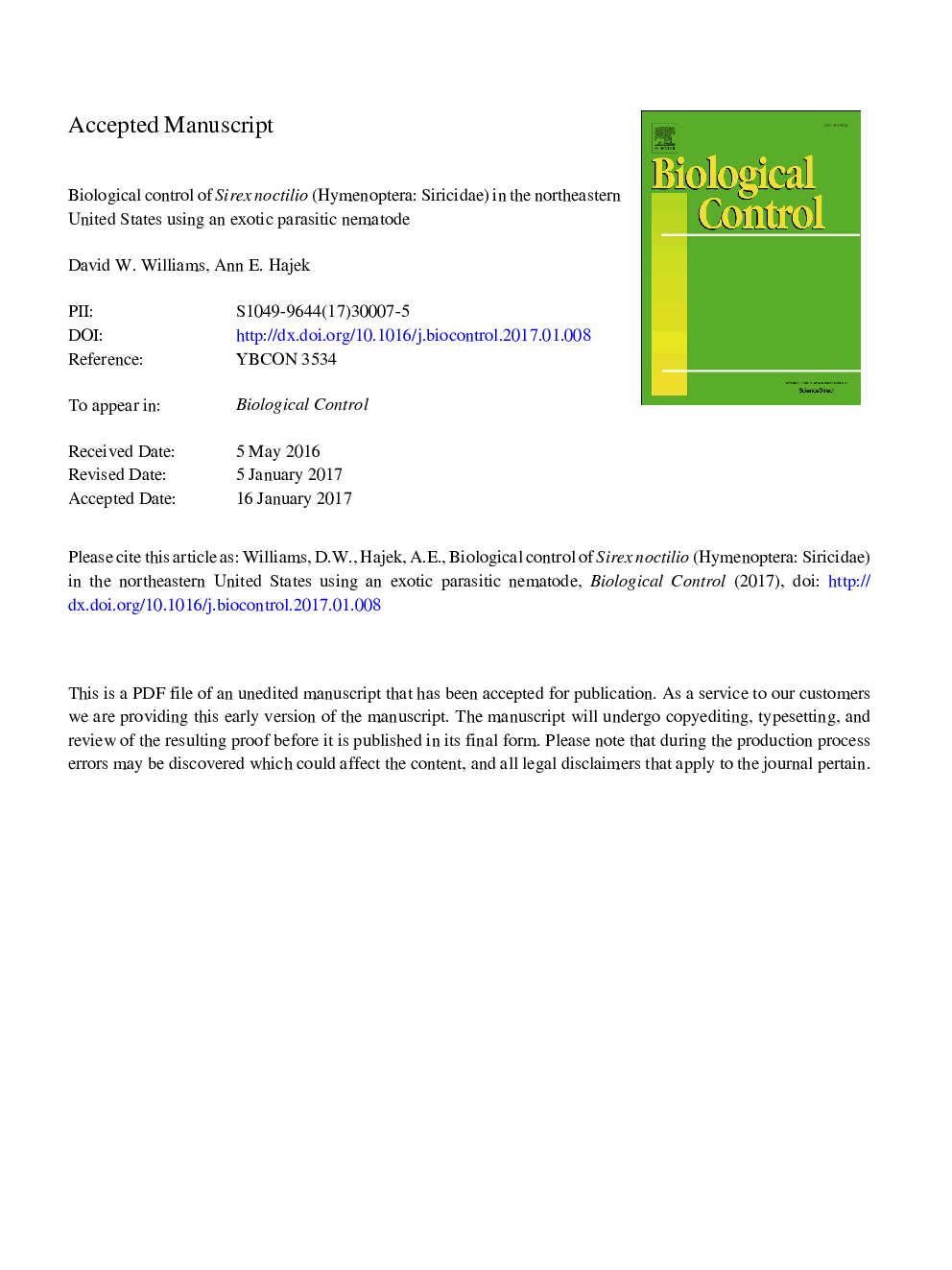| کد مقاله | کد نشریه | سال انتشار | مقاله انگلیسی | نسخه تمام متن |
|---|---|---|---|---|
| 5760668 | 1624227 | 2017 | 44 صفحه PDF | دانلود رایگان |
عنوان انگلیسی مقاله ISI
Biological control of Sirex noctilio (Hymenoptera: Siricidae) in the northeastern United States using an exotic parasitic nematode
دانلود مقاله + سفارش ترجمه
دانلود مقاله ISI انگلیسی
رایگان برای ایرانیان
کلمات کلیدی
موضوعات مرتبط
علوم زیستی و بیوفناوری
علوم کشاورزی و بیولوژیک
علوم زراعت و اصلاح نباتات
پیش نمایش صفحه اول مقاله

چکیده انگلیسی
The woodwasp Sirex noctilio is a devastating killer of pines in the southern hemisphere. Over the 20th Century, it has invaded exotic pine plantations in New Zealand, Australia, South America, and South Africa successively. In response to this woodwasp threat, in the 1960-70s CSIRO in Australia launched a major campaign of exploration for biological control agents in Europe, the Middle East, and North Africa, the presumed indigenous range of S. noctilio. The most promising natural enemy discovered was a nematode, Deladenus siricidicola, which lives inside a pine tree as a mycophagous form but becomes parasitic when near host larvae and sterilizes adult woodwasp females. Australian scientists developed a biological control management system based on the nematode, including how to rear and release it in the field. The CSIRO program has been a model for Sirex management in the pine-growing regions of the southern hemisphere since the 1960s. Thus, when S. noctilio was collected in North America in 2004, it seemed natural to try using the Australian model as a simple technology transfer. Unfortunately the transfer has not proved to be so simple. In the following, we present the results of six years of experimental controlled release studies, in which no nematodes were actually released into the field. One of the first discoveries was that another strain, a “non-sterilizing” strain, of D. siricidicola was already present in the areas invaded by S. noctilio. Our annual studies compared infection rates between trees inoculated with the Australian “Kamona strain” and controls without nematodes. In most cases, the treated trees had the higher rates of nematode parasitism, but the controls were not always zero, suggesting that the non-sterilizing strain was well-established in our study plots. Many of the Kamona-treated trees did not contain Kamonas, suggesting that the non-sterilizing strain may have out-competed the Kamonas. Even with Kamona treatments, there was relatively little sterilization, indeed much less than expected. It seems likely that the S. noctilio strain invading North America is physiologically different from the Australian nematode and not susceptible to Kamona sterilization. Another interesting result was observed between host tree species. In a three-year study, nematode parasitism rates were consistently higher in P. sylvestris than in P. resinosa and significantly higher when the three years of data were pooled. We conclude with the observation that the Kamona strain is apparently not compatible with the S. noctilio invading North America and suggest that more exploration is needed in its area of origin for different and more effective nematode genotypes.
ناشر
Database: Elsevier - ScienceDirect (ساینس دایرکت)
Journal: Biological Control - Volume 107, April 2017, Pages 77-86
Journal: Biological Control - Volume 107, April 2017, Pages 77-86
نویسندگان
David W. Williams, Ann E. Hajek,